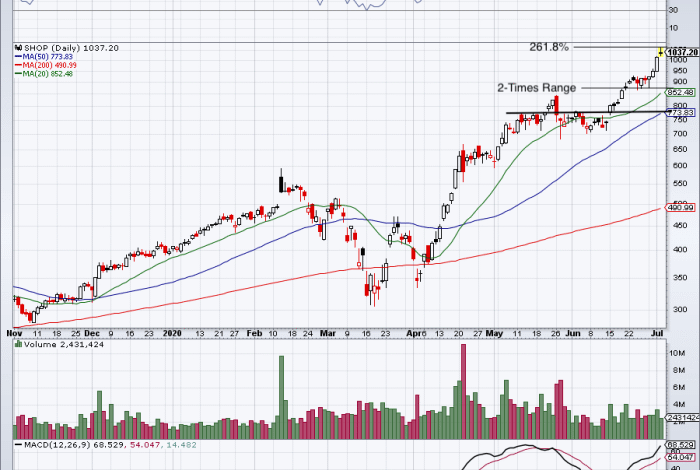Shopify Stock Guidance Hits Hard After Mixed Earnings Report

Navigating the complexities of Shopify stock guidance has become increasingly vital for investors, especially in light of the recent earnings report that revealed mixed results. For the first quarter, Shopify demonstrated significant revenue growth by reaching $2.36 billion, surpassing Wall Street expectations, but fell short with its profit forecast. The company’s leadership acknowledged that while some merchants may be insulated from tariffs, there remains a cloud of uncertainty concerning future trade policies. As Shopify prepares for its second-quarter performance, the anticipated gross profit increase at a high-teens percentage rate has investors on edge, given that analysts foresaw a more robust growth of 20.1%. With these outcomes in mind, the strategic insights unveiled during the Shopify investor call highlight the inherent challenges and opportunities that lie ahead for this prominent e-commerce platform.
Understanding Shopify’s financial outlook is crucial for stakeholders as the company shares its projections and navigates external pressures. Recent updates from Shopify’s earnings report reveal not only its revenue trajectory but also the potential impacts from international tariffs that could influence its business model. Investors are particularly keen on the company’s strategies for managing price sensitivities and sustaining profit amidst varying economic conditions. The anticipated growth rates shared during the latest investor discussions provide a window into Shopify’s adaptability in a rapidly changing e-commerce landscape. Moreover, insights into Shopify’s revenue strategies and their implications for market performance are critical as they look to maintain momentum despite external challenges.
Shopify Earnings Report Highlights
Shopify’s first-quarter earnings report revealed a mixed performance that led to a notable reaction from investors. Despite generating a revenue of $2.36 billion, which exceeded analyst expectations of $2.33 billion, the company’s earnings per share of 39 cents fell short of Wall Street’s forecast of 26 cents. This underperformance was attributed to soft profit guidance for the upcoming quarters, with expectations of gross profit growth in the high teens, below the anticipated 20.1%. Such a discrepancy highlights a level of caution among investors amid an evolving economic landscape.
During the earnings call, Shopify President Harley Finkelstein discussed the company’s outlook amidst increasing tariff implications affecting e-commerce. His remarks indicate that while Shopify has registered strong revenue growth year-over-year, the anticipated slower growth in profit margins has raised concerns. This report underscores the importance of continued monitoring of economic factors, including tariff policies, which are critical to Shopify’s future revenue trajectory and overall profitability.
Shopify Revenue Growth and Future Projections
While Shopify has experienced significant revenue growth, the latest guidance has somewhat tempered investor expectations. The company forecasted that revenue would expand at a mid-twenties percentage rate this quarter, slightly lower than analyst predictions of 22%. This growth reflects Shopify’s strong positioning in the online e-commerce platform space, benefiting from the rising trend of digital commerce and increasing demand for e-business solutions. However, the impact of tariff policies may weigh on small and medium-sized businesses that form the backbone of its merchant base, necessitating a careful assessment of future revenue projections.
Investors continue to scrutinize Shopify’s ability to sustain its revenue growth in a challenging market. The performance of gross merchandise volume (GMV) will be crucial in evaluating future prospects, particularly as forecasts indicated a slight shortfall in expectations. As consumer purchasing behavior evolves and higher-income buyers become a focus for Shopify’s strategy, the company’s plans to enhance local buying options may drive additional growth. However, uncertainties surrounding tariff impacts could pose challenges, warranting vigilance in how Shopify adapts its business model in response.
Impact of Tariffs on Shopify’s Business Model
The recent earnings report emphasized the uncertainty surrounding the impact of tariffs on Shopify’s business model. President Trump’s sweeping tariffs on Chinese imports create a complicated landscape for online retailers, including Shopify’s merchant base predominantly comprising small to medium-sized businesses. Given that only about 1% of Shopify’s gross merchandise volume is directly tied to imported goods from China subject to these tariffs, the immediate impact may seem minimal. However, the potential for broader economic repercussions necessitates a strategic response from Shopify.
As Shopify operates in an environment where global trade policies can shift rapidly, monitoring tariff impacts is vital for the company and its merchants. Many e-commerce platforms are now factoring in such uncertainties into their business plans. By adopting tools like the ‘buy local’ feature, Shopify aims to mitigate exposure while empowering consumers to support local businesses. Continued transparency about tariff influences and proactive adaptations will be crucial for Shopify as it navigates through these economic challenges and aims to maintain profitability.
Investors’ Perspectives on Shopify’s Profit Forecast
The cautious profit forecast shared by Shopify has caused some unease among investors, leading to a drop in stock prices at the time of reporting. It is evident that the financial market is particularly sensitive to any signs of potential underperformance. Despite the strong revenue figures, the lower guidance for profit growth has raised eyebrows among analysts who had higher expectations. This stock reaction highlights the importance of detailed explanations from executives during investor calls to clarify the reasoning behind such forecasts.
Investors are particularly focused on how Shopify will address the challenges posed by tariffs, as these external factors can significantly affect the company’s revenue stream. As the e-commerce sector continues to evolve and adapt to transactional hurdles like tariffs, understanding the long-term vision of Shopify becomes crucial. The company must outline how it plans to navigate through economic uncertainty while achieving robust profit margins, ensuring that investor confidence remains intact amid fluctuating market conditions.
Shopify’s Strategic Adaptations Amid Uncertainty
In the face of tariff-related uncertainty, Shopify has proactively sought to adapt its offerings to better support its merchants. The introduction of features like ‘buy local’ allows consumers to engage with local businesses directly, which not only mitigates potential tariff impacts but also fosters community engagement. Such strategic adaptations are essential as Shopify positions itself not just as a tech provider but also as a partner in growth for its merchants. These proactive measures can enhance customer loyalty and create more resilient business models among its user base.
Additionally, Shopify is closely analyzing market data to inform its strategy amidst these uncertainties. By actively monitoring customer buying habits and potential pricing pressures resulting from tariffs, the company can develop supportive measures to help merchants navigate changing conditions. This data-driven approach not only aids in keeping merchants informed but also strengthens Shopify’s overall value proposition in a competitive landscape. Maintaining an adaptive strategy amidst unpredictability will be key for Shopify as it continues to evolve and respond to market demands.
Stock Market Response to Shopify’s Earnings Call
Following the release of Shopify’s earnings call, market reactions have illustrated the apprehensions surrounding the company’s near-term future. A dip of more than 5% in stock prices reflects investor anxiety over the mixed financial results and the softened guidance provided for profit growth. This market response serves as a barometer for the confidence investors have in Shopify’s ability to navigate through economic uncertainties, particularly regarding tariffs that have the potential to disrupt operations. Analysts are now keenly observing the company’s forthcoming adjustments in response to these challenges.
Moreover, the stock market’s reaction underscores the weight placed on earnings forecasts and the significant role that executive comments play during earnings calls. Investors are likely to digest the insights shared by Shopify executives regarding tariff implications, growth strategies, and merchant support efforts. A clear articulation of the company’s strategy moving forward could play a major role in stabilizing investor sentiment and driving confidence back into the stock as the economic landscape evolves.
Shopify’s Consumer Demographics and Market Position
Understanding the demographic profile of Shopify’s consumer base provides insight into its market positioning. With more than half of Shopify’s buyers in the U.S. reporting incomes above $100,000, the company benefits from a less price-sensitive customer segment. This demographic advantage may buffer Shopify’s merchants against some of the adverse effects of tariffs that often pressure pricing strategies. By catering to a financially resilient consumer base, Shopify can potentially enhance its overall transaction volume and support revenue growth even amidst broader economic challenges.
Furthermore, Shopify’s focus on high-income consumers reinforces the importance of targeted marketing strategies. By developing products and services that appeal specifically to this demographic, Shopify can create unique value propositions for merchants. Such strategies not only drive sales but also foster brand loyalty among consumers, which is particularly valuable as competition in the e-commerce space intensifies. Emphasizing consumer demographics allows Shopify to solidify its market position while navigating the ever-shifting economic climate.
The Future of E-commerce Under Tariff Policies
The broader implications of tariff policies on e-commerce, while complex, present both challenges and opportunities for platforms like Shopify. As companies across the sector brace for potential impacts, it is crucial for Shopify to assess how these policies could shape the future of online retail. Tariffs may force businesses to rethink pricing, sourcing, and delivery strategies, prompting adaptations that could benefit agile operators that can quickly pivot in their approaches. Shopify’s ability to maintain operational resilience amid such changes will be critical to sustaining long-term growth.
As e-commerce continues to expand globally, Shopify remains committed to addressing these external factors by offering innovative solutions for merchants. Embracing changes in the economic landscape and responding to tariff implications with strategic foresight will position the company strongly in the market. Navigating this evolving terrain with a focus on supportive features and enhanced consumer engagement can ensure that Shopify stays at the forefront of the industry. Navigating future uncertainties will require ongoing adjustment and adaptability from Shopify to continue thriving in an unpredictable commercial environment.
Frequently Asked Questions
What impact do Shopify earnings reports have on stock guidance?
Shopify earnings reports significantly influence stock guidance as they provide insights into the company’s financial health. For example, in their latest earnings report, Shopify reported a revenue of $2.36 billion but issued light profit guidance, leading to a drop in stock price. Investors closely analyze these reports to gauge Shopify’s performance and future growth.
How does Shopify’s revenue growth affect stock valuation?
Shopify’s revenue growth is a crucial factor in determining its stock valuation. With a reported revenue increase of 27% year-over-year, the company demonstrates robust growth potential. However, their lower-than-expected guidance for the next quarter, forecasting gross profit growth in the high-teens percentage range, can raise concerns among investors about future performance.
What are the implications of Shopify tariffs impact on stock guidance?
The Shopify tariffs impact plays a vital role in shaping stock guidance, particularly in light of ongoing trade issues. Shopify management noted that while they expect limited exposure to tariffs, ‘uncertainty ahead’ could influence merchant pricing and profitability, which are critical for stock performance. Tariffs can lead to increased costs for merchants, potentially affecting Shopify’s revenue and stock price.
How do investor calls affect perceptions of Shopify’s stock guidance?
Investor calls, such as those held by Shopify executives, provide valuable context for stock guidance. During recent calls, CEO Harley Finkelstein addressed concerns about tariff impacts and provided transparency about the company’s financial outlook, including expectations for gross profit growth. Such communication helps investors understand the factors influencing stock performance and can lead to adjustments in stock valuations.
What is Shopify’s profit forecast based on recent earnings reports?
Shopify’s recent earnings report revealed a cautious profit forecast, projecting growth in gross profit in the high-teens percentage range, compared to analysts’ expectations of 20.1%. This softer guidance has led to concerns about the company’s ability to meet growth targets and may influence investor sentiment regarding its stock.
| Key Metrics | Q1 Performance | Guidance |
|---|---|---|
| Revenue | $2.36 billion (vs. $2.33 billion expected) | Mid-twenties percentage growth compared to last year (analysts expected ~22%) |
| Earnings per Share (EPS) | 39 cents adjusted (vs. 26 cents expected) | Gross profit to grow at a high-teens percentage rate (analysts expected 20.1%) |
| GMV | $74.75 billion (below consensus estimate of $74.8 billion) | N/A |
| Subscription Solutions Revenue | $620 million (vs. $621.5 million expected) | N/A |
Summary
Shopify stock guidance indicates a cautious outlook as the company issued lower-than-expected profit forecasts amidst ongoing tariff uncertainties. Despite healthy revenue growth, the executive team’s comments on potential challenges have led to a dip in share prices, reflecting investor jitters. As market conditions evolve, Shopify is actively working to navigate these uncertainties to support its merchants, particularly given the higher income profiles of its consumer base. This strategic approach may help insulate the platform from some economic fluctuations, although vigilance remains crucial.




